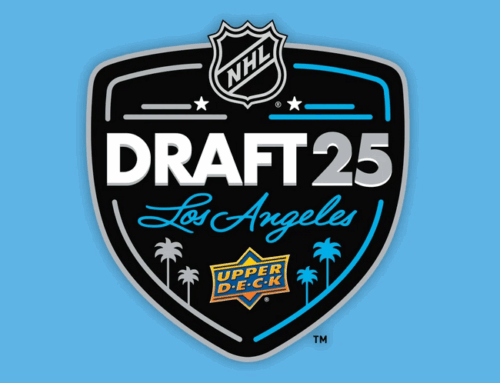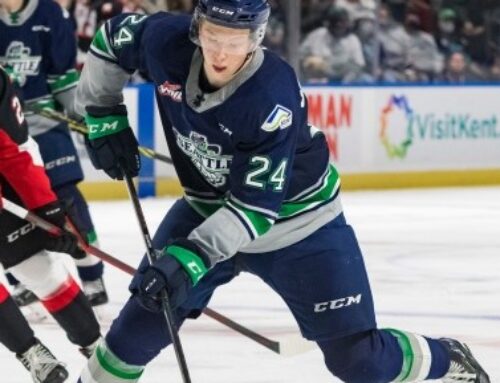Prospect Ramblings: 2023-Eligible Boom-or-Bust Prospects
Ben Gehrels
2023-02-02
Cover image: https://www.wkbw.com/
A few weeks from now, Dobber Prospects will be releasing the 2023 edition of our annual NHL Draft Fantasy Rankings. As part of my process for preparing for that article and establishing a Top 32 that I feel good about, I have identified a couple players who have both dynamic skill sets and a bunch of red flags—recent examples would be players like Brad Lambert, Jagger Firkus, Fabian Lysell, and Noel Gunler.
These are boom-bust players: they might become NHL stars or flame out and never see a game at the highest level. Because fantasy managers, myself included, love grabbing players with potentially high upside towards the end of a draft when all the sure bets are off the board, I thought I would highlight them here so you can keep them on your radar as draft season approaches. I will share their rank, reputation, and skill set, as well as what the tracking data and historical comparables suggest about their likelihood of making and starring in the NHL.
Quentin Musty
LW, 6’2, 205lbs
Highest Rank: 14th (Eliteprospects.com)
Lowest Rank: 36th (TSN/Craig Button)
Consolidated: 24th
Pros:
– Powerful, accurate wrist shot
– Skating, edgework
– Puckhandling, dekes
Cons:
– Processing speed
– Scanning, vision
– Playmaking
– Often loses puck battles
The overall picture on Musty is that he has great size and a high-end skillset but his brain cannot currently keep up with what his hands and feet are capable of doing. In this way, he reminds me of Lambert (WPG), who has become known for carrying pucks with blazing speed through the neutral zone but then skating into the corner and killing the play, and Logan Mailloux (MON), who likewise has a great toolkit but routinely attempts to beat three opposing players back to back—an approach that can work in junior but will not translate well to the NHL.
Here are a couple examples of Musty’s high-end shot. The first is from the Ivan Hlinka Memorial tournament this past August; he receives a perfect pass at the right circle and unloads an absolute laser beam top shelf past the Finnish goaltender from a stationary position. In the second clip, he smoothly strips the puck from an opposing player, then uses another defender to screen the goalie as he rips a smooth wrister past his glove side.
Musty’s calm poise with the puck as he pulls off little eye-popping moves also stands out to me. In the following sequence, for instance, he receives an awkward pass in the defensive zone. Facing pressure from defenders both in front and behind, Musty pulls a slick move through the feet of the first opposing player, then exits the zone with speed and forwards the puck ahead to an open teammate. Using his hands, he is able to calmly complete an important zone exit that then leads to his team pressuring for a goal.
His playmaking has been listed as less of a strength than his goal scoring, but that has less to do with his passing ability than his average processing speed and tendency to have tunnel vision with the puck. When there is an obvious play to be made, such as the two-on-one situation in the following clip, he has no problem physically executing difficult passes.
Mitch Brown’s tracking data paints a similar picture: Musty’s primary impact on the game is on offence, where he consistently generates shots and high-danger plays at the OHL level. Musty is well above average in both xA1/60 (expected primary assists per 60 minutes) and xG/60 (expected goals per 60 minutes), suggesting that he is one of the premier dual-threat producers available in this draft.
Where he struggles is on defensive plays, high-risk passes, and to some extent in transition on controlled exits. That high-octane offence is likely worth the price of some defensive gaffs—like in the following sequence from the Hlinka when he loses the puck after attempting an ill-advised dangle instead of utilizing his several open teammates.
In terms of trajectory and historical comparables, Musty is looking a bit like a young Thomas Vanek, whose effectiveness and production were directly tied to how willing his coaches were to give him sheltered, preferential deployment.
Musty is having an excellent draft year production-wise with 48 points in only 32 OHL games. His current ranking suggests that he may be selected towards the end of the first round at this year’s draft, though he could fall out of the first round entirely if teams think that his defensive and processing deficiencies are too concerning. He will be a player I will target with my second- or third-round pick in fantasy drafts this spring because he has the upside to become an exciting asset if everything breaks right.
William Whitelaw
C, 5’9, 172lbs
Highest Rank: 16th (Eliteprospects.com)
Lowest Rank: 65th (TSN/Bob McKenzie)
Consolidated: Notable Prospect (outside Top 32)
Pros:
– Speed, mobility
– Shot
– Stickhandling
– Playmaking
Cons:
– Tends to stay on the perimeter instead of driving the middle
– Undersized
– Inconsistent effort, engagement, and decision making
– Individualistic
It is never a good sign when Bob McKenzie’s rankings are much lower on a player than most outlets in the public scouting sphere. Whitelaw is generally thought to be a mid-first to mid-second round talent but McKenzie—whose rankings are generally most in tune with what NHL executives are thinking and valuing—has him at the top of the third. The range of opinions on Whitelaw’s slotting, a variance of nearly fifty positions, speaks to his status as an intriguing and divisive boom-bust player.
Dobber Prospects’ Head of North American Scouting, Sebastian High, wrote a telling report on one of Whitelaw’s games in which he landed 12 shots on 15 attempts. Whitelaw is often central to his team’s offence, and while it is not a bad sign to shoot a lot, it often means players are underutilizing their teammates. Selfishly speaking for fantasy purposes, I love to see a high shot rate from a player. But the concern would be that NHL coaches will curtail his ice time if he attempts to play the wide-open, freewheeling style that suited him so well in high school at Shattuck-St.Mary’s.
As High notes, Whitelaw has “shown more consistent flashes of sharing the offensive responsibility as the season has progressed. He had a few nice give-and-go’s in this game, and even flashed a delay game a few times.” What fantasy managers will want to see from Whitelaw is a more balanced approach to the game that sees play run through him in a way that makes his teammates better and gives his team the best chance to win.
Here he is back in the summer at the Hlinka putting on an absolute possession clinic against the Germans. The puck is seemingly back on his stick every few seconds, and he is directly responsible for setting up several high-danger scoring chances for his teammates that they unfortunately cannot capitalize on.
Whitelaw has the same composure under pressure with the puck on his stick as Musty does. If he can approach the game with more consistent intensity and learn to utilize his teammates more effectively—both of which seem likely to me—then Whitelaw will have a chance to be one of the more dynamic talents in this draft, which is saying something given the depth available this year.
Brown’s data suggests that Whitelaw is a slightly less dynamic but more balanced player than Musty. The data also echoes High’s observation of Whitelaw being overly individualistic and trigger happy: his Shots/60 is off the charts over the five games tracked. As we saw in the clip above against Team Germany in the summer, Whitelaw’s tenacity, positioning, and spatial awareness mean that he is strong in transition and can often retrieve pucks in the offensive zone to maintain pressure on the opposing team.
While Whitelaw looks a bit more competent than Musty on the defensive end, we should remember that this data is from a relatively small sample size and that the USHL is known for its wide open hockey and passive defensive structures versus the elevated quality of competition in the OHL.
In terms of Whitelaw’s NHL projection, he currently has a slightly lower chance of becoming a star than Musty. Brock Nelson and Jori Lehtera likely represent the upper and lower ranges of his NHL potential: one who has one 37-goal season and has threatened for thirty a handful more times, while the other looked like he would stick in the majors when he debuted with a 45-point season for the Blues but then he ended up back in the KHL after just a few years.
Whitelaw will likely hear his name called on Day Two come June, and he would make an attractive target in fantasy around picks 30-40. If he can grow a bit (even one more inch!) and pack some more weight on his 5-9 frame, that will help assuage concerns that he will be pushed around easily at the next level.
Thanks for reading! Follow me on Twitter @beegare for more prospect content and fantasy hockey analysis.





